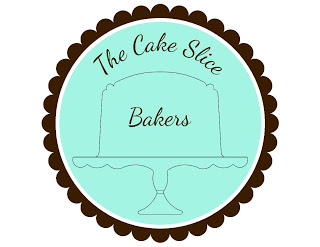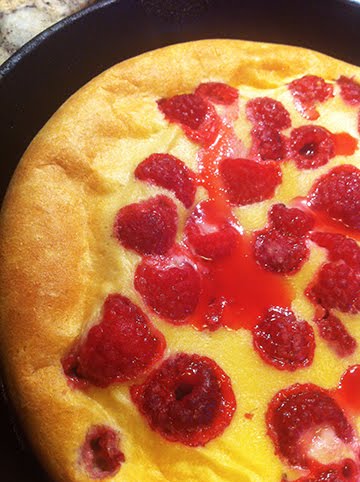I've always been a water baby. I love baths, swimming, walking in the rain. I'm also an Aquarian for my horoscope...a water sign. Perhaps that's why this month's recipe caught my interest. I was reading bread recipes in Beard on Bread. James Beard was the American chef who was most instrumental in having Americans take pride in American food in the 50's, 60's and 70's when gourmet food was always food from another, country, especially France. It's a great book.
The Water-Proofed Bread uses a rising process I'd never heard of.
Here is what he writes about his Water-Proofed Bread: "Although the dough in this recipe is fairly difficult to handle, it makes a very delicate, brioche-like bread with a rich, buttery, eggy taste. It is extraordinarily good, ideal for tea or for eating with butter, jam and marmalade, and toasts extremely well. It can be wrapped in plastic and frozen for 3-4 weeks. The bread is called "water-proofed" because the dough is submerged in a bath of water for the first rising."
In searching the internet I only found one place where someone had tried this and they liked it but moaned about a ruined tea towel, then went on the make the next water-proofed dough in the book without water-proofing it. I guess I want to see if it is worth a soiled tea towel. I've never seen this method anywhere else and am a sucker for different methods, so I chose it for this month for the Bread Baking Babes since I'm Kitchen of the Month.
See, it floats!
The Water-Proofed Bread uses a rising process I'd never heard of.
Here is what he writes about his Water-Proofed Bread: "Although the dough in this recipe is fairly difficult to handle, it makes a very delicate, brioche-like bread with a rich, buttery, eggy taste. It is extraordinarily good, ideal for tea or for eating with butter, jam and marmalade, and toasts extremely well. It can be wrapped in plastic and frozen for 3-4 weeks. The bread is called "water-proofed" because the dough is submerged in a bath of water for the first rising."
In searching the internet I only found one place where someone had tried this and they liked it but moaned about a ruined tea towel, then went on the make the next water-proofed dough in the book without water-proofing it. I guess I want to see if it is worth a soiled tea towel. I've never seen this method anywhere else and am a sucker for different methods, so I chose it for this month for the Bread Baking Babes since I'm Kitchen of the Month.
See, it floats!
The theory is that the dough, being delicate, will benefit from rising in water where the water barrier will keep the yeast produced gases inside the dough, for a better first rise. Having it wrapped in a tea towel is probably necessary since Beard says this is a sticky dough, even when the first kneading is done.
I also like the description of the finished bread. Since I'm restricted in how much bread I can eat, it is nice to choose one that I can enjoy with tea and enjoy toasted! Hope you enjoy it, too. Knowing the creativity and boldness of the Babes, we might end up with some whole grain flours or herbs or cardamom...who knows? Let's get watery!
PLEASE VISIT the OTHER BREAD BAKING BABES sites, too. Links are at the bottom of this post.
I particularly want to introduce our two newest Babes, Aparna and Cathy. They are both awesome bread bakers and delightful bloggers.
Water-Proofed Bread
from Beard on Bread, 1973makes two loaves
2 packages active dry yeast
1/2 cup warm water (100 - 115 degrees F, approximately)
1/4 cup plus 1 teaspoon granulated sugar
1/2 cup warm milk
1 stick (1/2 cup) butter
2 teaspoons salt
3 eggs
3 1/2 cups all-purpose flour More flour for the tea towel
Rinse a 4-quart mixing bowl with warm water. Dry thoroughly. Put in the yeast, the 1/2 cup warm water, and the teaspoon of sugar, and stir until the yeast dissolves. Allow to proof for 5 minutes.
Heat the milk with the butter and 1/4 cup sugar until lukewarm, then add to the yeast mixture. Add the salt and stir to blend well. Add the eggs, one at a time, and again blend thoroughly.(Note from Elle: I actually added 1 cup of flour after the salt and before the eggs, just to give the mixture a little body. That seemed to work well. I added the rest of the flour after the eggs had been stirred in one at a time until well blended.)
Then stir in 3 cups of flour, 1 cup at a time, to make what will probably be a very wet and sticky dough. Stir quite vigorously.
Spread out the dough on a working surface - a table, a piece of marble, or a board - sprinkled with the additional 1/2 cup flour. Use a baker's scraper or large spatula to work in this last portion of flour and make the dough firmer. Scrape under the flour and the dough, lifting and folding inward. Repeat until the flour is well incorporated. When the dough is easy to handle, begin kneading by hand. (Note from Elle: I worked in another 1/2 cup flour here.)
Continue until the dough can be shaped. (The process of kneading first with the scraper and then by hand if very effective for delicate dough. In this case the dough will remain rather sticky, but don't worry about it.)
Lift the dough, pat with flour, and place on a clean kitchen towel also sprinkled with flour. Wrap it and tie it in the towel, just as you would a package, but very loosely. Submerge this packet in a large bowl filled with warm water (about 100 - 115 degrees F, approximately). It will sink. Let sit for about 35 to 40 minutes, or until it rises sufficiently to float on top of the water. (Note from Elle: Took mine closer to an hour). Lift the dough from the water and let the excess water drip off.
Un-wrap and turn out on a lightly floured surface. Again it will be quite sticky, so scrape off any dough that adheres to the towel. Knead and shape into two loaves, using both dough scraper and your hands. Thoroughly butter two 9 x 5 x 3-inch loaf pans and place one loaf in each pan. Cover, put in a warm, draft-free place, and let the dough rise slightly above the tops of the pans, or until almost doubled in bulk.
Meanwhile preheat the oven to 375 degrees F. Brush the dough with cold water, and, if you like, make a slash in each loaf with a sharp knife. Place on the middle rack of the oven and bake for about 30 - 35 minutes, or until the loaves sound hollow when rapped with the knuckles, top and bottom. When done, place the loaves directly on the oven rack, without their pans, to brown the bottom a little more and crisp the crusts. Cool on racks.
Well, that was fun! The water proofed dough is in the pans doing the final rise, and it worked...the dough packet floated to the top. I did find that the dough around the towel was a bit wetter than the dough further into the dough ball, so I made sure to really do a thorough knead with the bench scraper once I turned it all out onto the floured board. That also worked in the wetter bits I scraped off the tea towel.The tea towel rinsed out pretty well with cold water, and I ran it through the washer to finish the job.
Since I did all that kneading, the dough was really knocked down. It took a while for it to rise in the pan, but after it baked it was be a lovely, light, luscious bread! I was delicate, rich and had a nice moist crumb. Very tasty! Makes excellent toast, too.
Here are the links for the wonderful, talented, and inventive Bread Baking Babes (I know, no 'B' adjectives, but I had too much Scotch last night when we celebrated Sweetie's birthday, so lets roll with what words I can dredge up, OK?). Do visit their sites and see how this turned out for them.
Katie of Thyme for Cooking, our Fabulous Round-Up Babe
Bake My Day - Karen
Blog from Our Kitchen - Elizabeth
Bread Experience - Cathy
Girlichef - Heather
Life's a Feast - Jamie
Living in the Kitchen with Puppies - Natashya
Lucullian Delights - Ilva
My Diverse Kitchen - Aparna
My Kitchen in Half Cups - Tanna
Notitie van Lien - Lien

















This was a fun pick Elle, love it when it works as written! A delicious bread, great as french toast (pain perdu) too!
ReplyDeleteThis was my first bread book and I have always loved it. This was a recipe that I had not seen and I've bake a lot out of this book.
ReplyDeleteA unique technique to have tried and good bread too.
It sure was fun Elle, I didn't have much hope for my package all down on the bottom but I loved to see it all risen bobbing on the surface.
ReplyDeleteThanks for an original pick!
(and your loaves look fantastic!)
What an funky method. I wonder what made him think of trying this? I looked it up in my 74' copy of Beard on Bread and see that the recipe immediately following this is for water-proofed egg twists. Is it okay if I try this one instead? (it's still the same method)
ReplyDeleteSandie
Well!! Wasn't that fun?! And it certainly was delicious! We never did manage to toast any of it and just ate it warmed with butter and apricot jam or honey. I loved it with apricot jam but surprisingly, I think it was most thrilling with honey.
ReplyDeleteThank you for getting us to push the envelope!
Incidentally, your bread looks beautiful!
Lien, The French toast with this really is wonderful, glad that you had fun with it, too.
ReplyDeleteTanna, It's an excellent book, even if old fashioned. Unique says it about the technique. :)
Baking Soda, Love at fist bob, right?
Sandie, Yes, the twists would be fine since we are really going with the technique this time, plus I would love to hear how it works for you!
I have 'Beard on Barbecue'.... Or something like that - old cook book with some great stuff in it. You are indeed adventurous - and the babes all had such fun with this one! (OK, a few complaints and we all know from who ;-))
ReplyDeleteThis was the most amazig way of proofing bread I've ever tried (ah ah, I am talking as if I've been baking breads forever!!! - Does 2 years count as "forever"?)
ReplyDeleteThank you so much for having chosen this recipe, Elle.
It's fantastic, easy and sooo delicious.
PS.Do you think water proofing can be used for any bread dough?
Challenge accepted. Couldn't resist trying this method with sourdough. I thought it would turn out to be a mucky mess but was surprised how easily the dough pulled away from the soggy towel. I never make sourdough during the summer because of the heat and humidity where I live. Using a cool water bath would be the perfect solution. It's also a great way to control the environment for finicky dough like brioche. Will give the brioche recipe a try. Thanks for the inspiration
ReplyDeleteKatie, I have a couple other books by Beard. The Fireside one has fun illustrations and very 50s recipes. I am so glad the Babes found this fun to do.
ReplyDeleteSweet, I think this method could work well with other breads...see next comment after yours. Two years might not be forever, but it is awesome. Some people give up quickly, so you are indeed an experienced bread baker. Thanks for baking with us.
Gigi, So glad you tried it with sourdough. I agree that this method helps when proofing conditions, like air temperatures, are not ideal. This way sort of provides an ideal proofing temperature, as long as you don't mind a little mess. :)
Thank you, Elle, for picking a bread that stretched my limits--and tasted sooo delicious. We loved it with a dinner of braised chicken and mushrooms, and later, sliced thinly, with jam for dessert. I thought of not using the method, just raising in the regular way, but I'm glad I tried this--and my towel cleaned up beautifully with the dough scraper. Thank you!!!
ReplyDeleteThank you, Elle. I have the Beard on Bread book, but never thought of baking this one--and I'm so glad I did. We loved the flavor and tenderness. This may be heresy, but we loved it with braised chicken and mushrooms for dinner, and then afterwards, sliced thinly with jam. Yummm!
ReplyDeleteDear Elle!
ReplyDeleteThanks for perfect recipe!
Hungary is known for its technique: old traditional cake is made this way. My mother often baked so it's cake.
Wonderful memories <3
I kept every instructions:
http://szeretetrehangoltan.blogspot.hu/2014/03/vizben-kelt-desszertkenyer-water.html
Best regards
Mági
Have looked for this method for years. My mother used the water method for a braided coffe cake that she made for special occassions. I was very young the last time she made the coffee cake.
ReplyDelete